09 March 2024
|
In the final part our Buying Guide, we look at the vast array of Defender upgrades and Special Editions for you to choose from
Top upgrades
Name an accessory and the chances are there will be a Defender with one fitted, such is the scope for modifying the vehicle. And while some may need a crop sprayer on the back of their 110, it won’t be for everyone – but there are a few upgrades that everyone will benefit from.
Heated windscreen
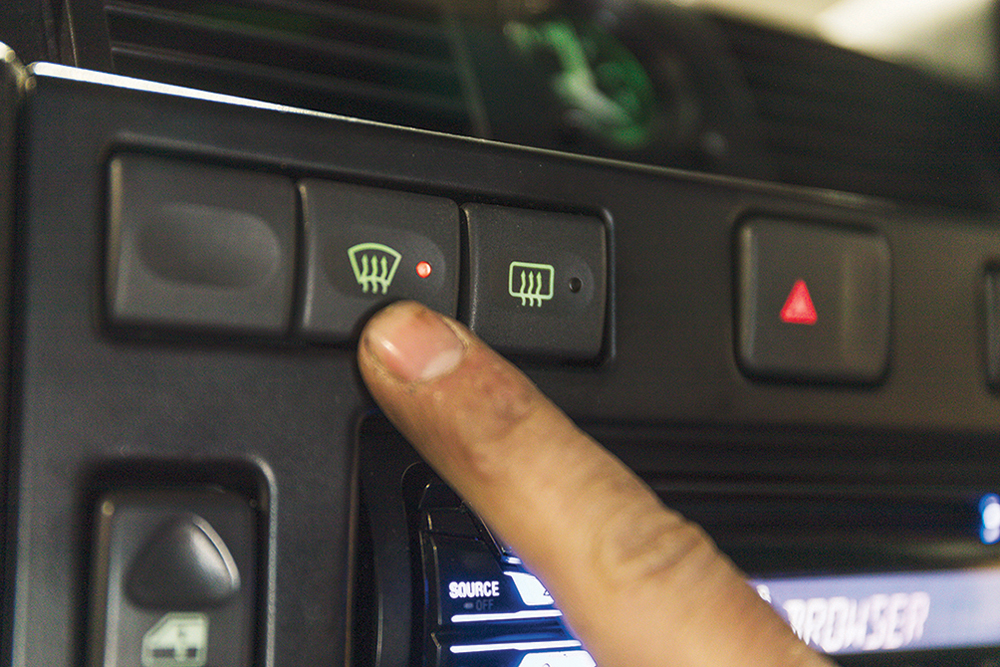
Even the TDCi models with their updated heating systems struggle to demist the windscreen, be that on an icy morning, or when you – and maybe your dogs – get back in after a rainy walk. A heated windscreen speeds up your departure, and it can be clear by the time you’ve scraped the side windows. We showed how to fit one last issue (LRM, Feb 2024) and it’ll cost you around £360 for a screen and wiring. Treat yourself by also fitting a pair of Mud UK heated mirror elements (£36) for clearer rear vision.
Lights
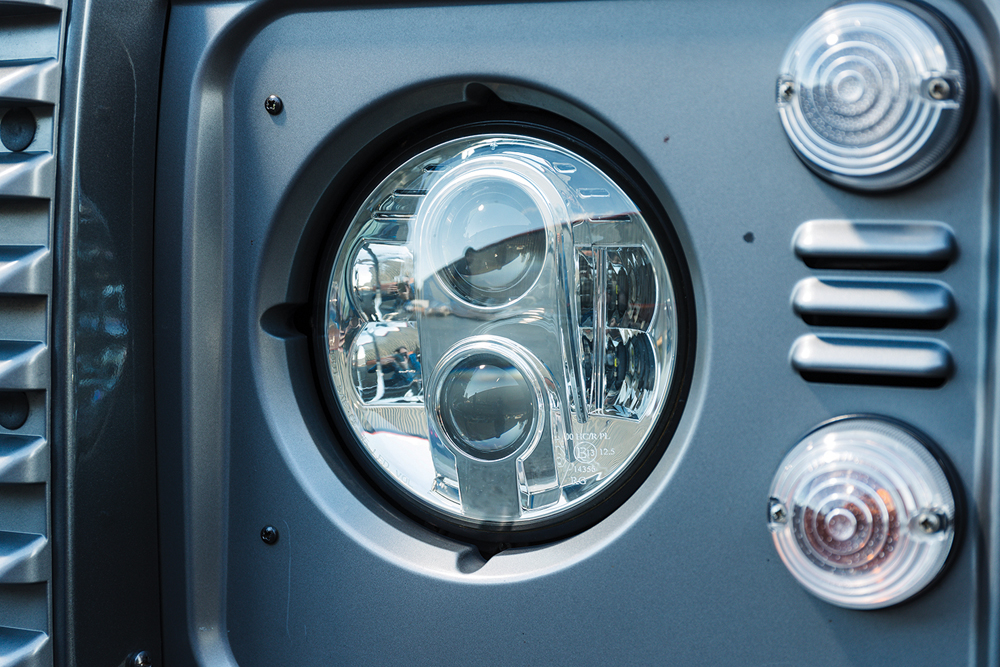
Are standard Land Rover headlamps really that bad? Seven-inch headlamps have been around for 70-plus years and there have been gradual improvements in optical design over the decades, and they are functional. But compared with the bright and clear offerings available on newer vehicles, the lights seem weak and feeble. Upgrading halogen units to brighter filament bulbs is a cheap way of getting more light from them, but do not fit HID and LED bulbs into halogen headlamp units. Both are singled out as an MoT fail on vehicles first used on or after 1 April 1986.
You can also give the vehicle electrics a hand by fitting a loom supplying the headlamps with relay-switched power – that reduces the load on the switch and also removes resistance in the circuit improving the voltage, and therefore brightness, at the lights.
Another option is to fit completely new LED headlamp units. These must carry the appropriate marks (an E-mark in the UK and Europe) to show that they are legal. We have heard that some people have had their Defenders fail MoTs when fitted with legal LED headlamp units because they don’t have levelling suspension or headlamp washers, but there is no requirement to have either of these – the UK MoT Testers’ Manual states: ‘Vehicles with high intensity discharge (HID) or LED dipped beam headlamps may be fitted with a suspension or headlamp self-levelling system’. The key word to take away from that sentence is ‘may’, rather than ‘must’.
Full LED light kits are also available for the other external lights – they tend to be more water-resistant than the standard units, as well as drawing less power.
If you want better main-beam lighting, there’s a multitude of driving lamps available, from LED units to old-school circular ones. If they’re switched on with the main beam, they must be E-marked when used on vehicles first used on or after 1 April 1986.
Tyres
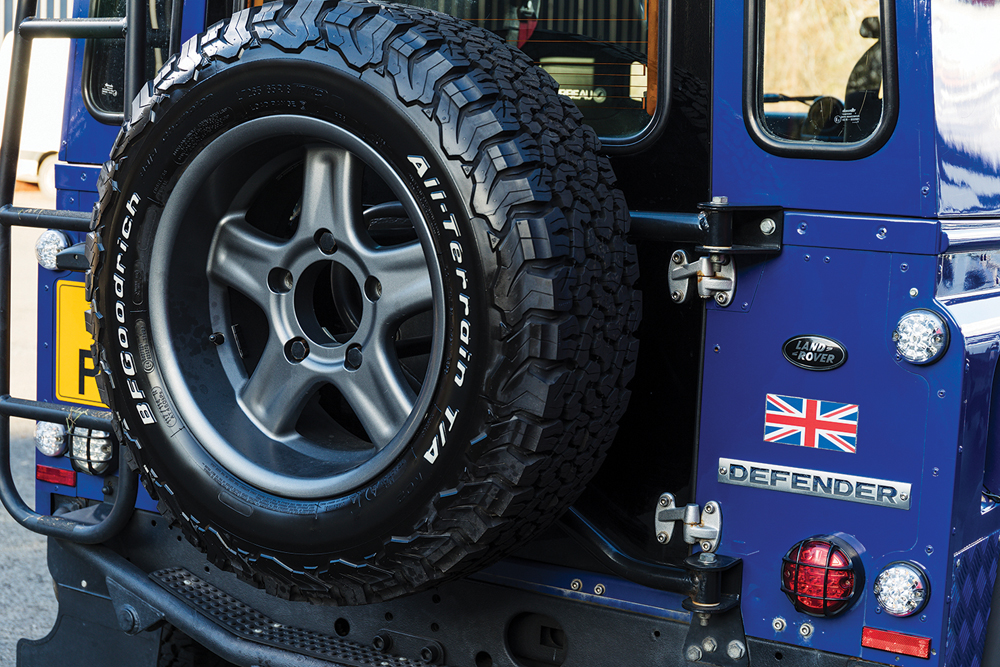
There is no single ‘fits-all’ tyre that will work for every owner, but there may be one that’s perfect for your use. It’s common sense not to fit mud-terrains to a Range Rover Sport SVR that you use for hurtling up and down motorways, and there’s no sense in fitting fast road tyres if your work or hobby takes you along muddy tracks – neither the Land Rover or the ground will thank you for spinning up.
There are now six real groups of tyres available for Land Rovers, ranging from fast road to extreme, so you’re bound to find a segment for you. The segments are Fast road, Road, All-terrain, Rugged-terrain, Mud-terrain and Extreme. On top of that, you have winter and all-season tyres – which fall within Road; most all-terrains are rated for winter, while the more off-road-biased tyres tend to have M+S (mud and snow) designation.
Sound deadening

Even if you’re using your Defender as a short-hop work truck, some sound deadening won’t go amiss – it makes the Land Rover a nicer drive. Different types are available depending on the sort of use you put your Defender to – if you use it in muddy places and need to be able to hose it out and you have an LT77 or R380 gearbox, the tough Wright Off-Road matting will do the job. For later models, and those fitted with carpets, there are numerous products that’ll reduce the din. A mix of closed- and open-cell material will give the best results – the closed-cell pads reduce drumming, exhaust and road noise, while the open-cell absorbs frequencies that would otherwise pass through the sheet. Comprehensive kits for most Defenders can be bought from soundproofing expert NK Group, and you can buy stick-on Dynamat, for use below-carpet, from Britpart stockists.
Security

We’ve mentioned it elsewhere, but if you are getting a Defender, splash the cash on some security upgrades – you don’t want to throw loads of accessories at it only for it to be stolen and you lose the lot. Layers of security from immobilisers to tracking devices and mechanical deterrents is the best way to go – we shouldn’t have to, but unfortunately we need to. And remember to inform your insurer about any upgrades you make just in case the worst does happen.
In-car entertainment

If you want built-in sat nav on a Defender, you’re going to have to find a Works V8 edition, otherwise you’ll need to fit some yourself. Yes, you can throw your phone into a mount on the windscreen or attached to the dashboard – Ram Mounts are very good for this – but it’s better to have a dedicated screen. And with loads of us using Apple CarPlay and Android Auto, you can access your apps with ease. The easiest upgrade for a pre-TDCi Defender is a single-DIN unit with large touchscreen, which start around £400. There is room to fit a double-DIN unit in TDCi models if you relocate the switches and use a new fascia, and Stinger has just released the HEIGH10, which is built into a fascia and accommodates the switches – simply remove the old one, swap the switches over and replace, and you’re good to go.
Uprated seats
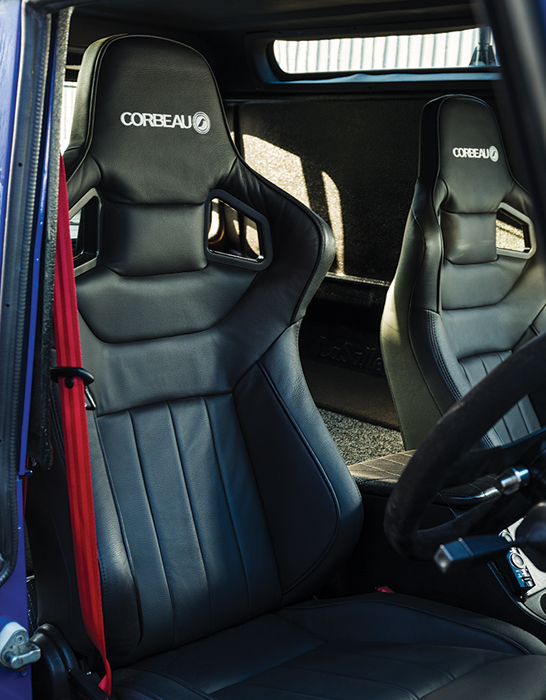
Standard Defender seats are reasonably comfortable, but while the basic trim vinyl versions are functional for a workhorse, they aren’t that comfortable for longer drives. Cloth and leather (part or full) tend to be better if you’re spending long periods in the seats. Fortunately, you can retrim them in the fabric of your choosing – a cloth retrim kit with base and back foams for two seats starts at around £300, and it’s fairly easy to do at home. Alternatively there are numerous companies like Exmoor Trim and Ruskin Design that will build you a fresh set to your own spec. Later TDCi seats are a good upgrade for earlier models and they are a straight replacement, while plenty of more luxurious seats are available, up to Recaros which were fitted to some special edition Defenders.
Transmission upgrades

While the standard Land Rover parts are perfectly fine for everyday use, they are designed for a certain lifespan and there are certain upgrades you can make to reduce vehicle downtime. Slack in the transmission has been an issue with Land Rovers from the start, but became even more noticeable with the permanent four-wheel drive offerings, including the Defenders. A small amount of wear in any component will cause thunks and clunks as you pull away or brake. One-piece rear halfshafts can be fitted to Defenders with Rover rear axles, removing the wear point at the drive flange. Or you could go for heavy-duty halfshafts matched with HD flanges – they will wear far slower than standard items.
Propshaft universal joints only have a finite life – which can be shortened considerably if they’re not greased – so replace them with beefed-up items when they need changing. Heavy-duty GKN ones from Gwyn Lewis 4x4 have 18mm trunnions rather than the standard 16mm, making them stronger. They still need greasing, though.
Other upgrades depend on the model. There has been a spate of 2012 Defender front axles collapsing through sub-standard welds – and Land Rover has issued a recall on affected vehicles, which just keeps the hub with the axle if it does snap. It’s better to fix the problem for good with a replacement axle casing. The output shaft on the six-speed gearbox fitted to the TDCi models is a known problem area – a lack of lubrication causes it to wear prematurely and you’ll lose drive. Fit an upgraded version from Ashcroft Transmissions (£354 plus fitting) to banish this common problem.
Special Editions
It may seem surprising now with the demand for all things Defender still being high and the latest offerings from Land Rover Classic being snapped up within a matter of days, but some of the limited editions turned out to be slow sellers. Whether it wasn’t the right time for them, the wrong price, wrong spec, or just special edition fatigue, some sat around for ages. And when the Defender was still in production, used special editions still weren’t that sought-after – and many just got used as standard vehicles and reached the end of their naturals lives.
Are they worth searching out now? They’re definitely interesting parts of Land Rover’s history and will typically command a premium over the equivalent age standard models of the day. The only wrinkle is that to command top-dollar they need to be in superb original condition, and have all of the kit and preferably ephemera, like sales brochures, with them. One that’s been messed around with is just another Defender now.
UK and Worldwide models
90SV, 1993, 200Tdi

While those across the pond were getting V8-powered Defenders, you had to make do with a 200Tdi if you wanted a limited edition Defender in the UK. The 90SV was Land Rover’s push into the leisure market and was a soft top only, with Caprice mica metallic paint – a greeny-blue, depending on the light. It launched in 1993, Land Rover’s 45th year. The chunky roll cage stretched forward over the windscreen to give some proper roll-over protection, but did cause problems with keeping the inevitable UK rain from finding its way in past the bright and airy hood – which even includes alpine lights. Funky bright graphics adorn the wing panels behind the front wheels and the rear wing above the Defender decal. The chunky looks continue with the thick five-spoke wheels, as used on the Range Rover LSE, steel A-bar and driving lamps, while the spare wheel is mounted on its own carrier which opens with the side-hinged tailgate.
These models have always been sought-after and with only 90 having been made, they are rare – you’re looking at £30k+ to put a good one in your garage.
50th Anniversary, 1998, 4.0-litre V8 petrol
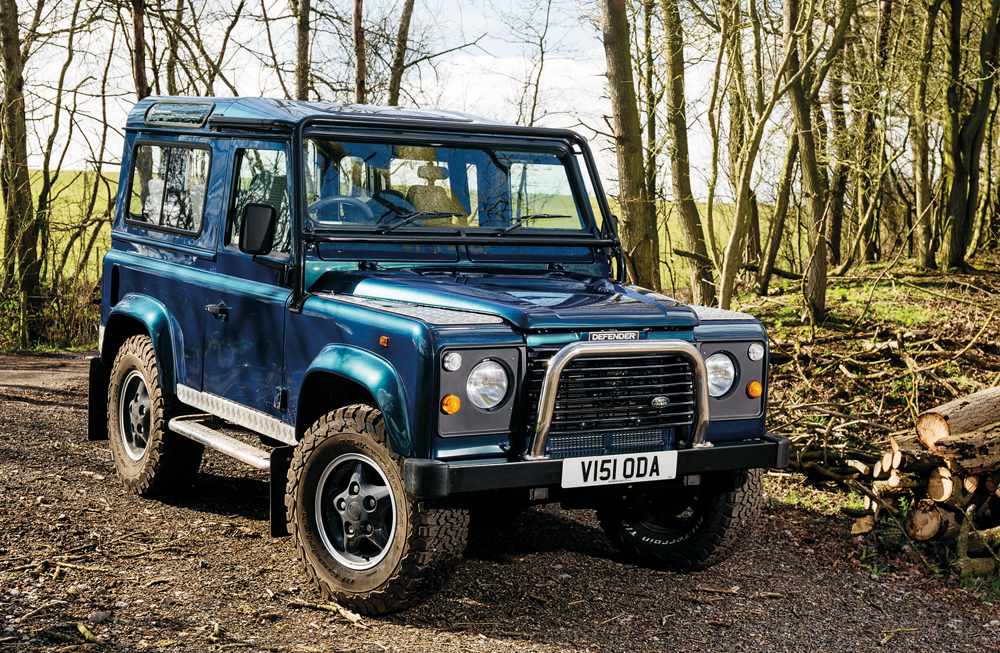
Many enthusiasts moaned that the 90SV with its diesel engine was a bit lacklustre compared with what the Yanks were being offered, and Land Rover decided to do something about that for its 50th anniversary, with this celebratory Defender. In fact, it was one of two times that the entire Land Rover model range was treated to a factory special edition, with the Freelander, Discovery 1 and Range Rover P38 also being offered in the anniversary Atlantis Blue. The Defender had the best spec available at the time – stuff that would later become part of the higher-spec offerings, like leather steering wheel, bulkhead removal and air con. Aluminium touchpoints came in the guise of the transfer gearbox lever and window winders, but it was the 4.0-litre V8 engine and automatic transmission that got the hearts fluttering, making for a truly desirable package. Outside, aluminium highlights were a thing on top of the North American Spec (NAS) rear step, sills and rear corners, while Gun Metal Grey alloy wheels and external front roll cage gave more of a presence.
While the 50th Anniversary was well received, there was a time in the late 2000s where demand for them dropped, but it has since picked up – and you’ll be looking at around £35,000 for a reasonable one and a lot more for a minter.
Heritage, 1999, Td5
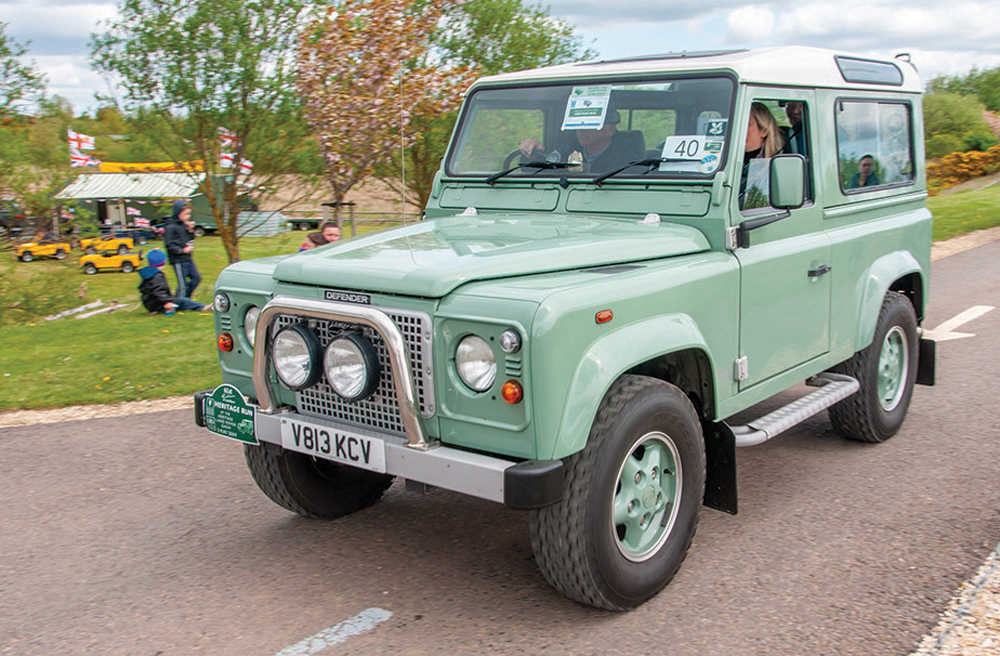
We’re not saying that Land Rover wasn’t that creative when it came to names, but Heritage appeared twice in the Defender limited edition range, with the first being in 1999. Available in two colours, both traditional greens harking back to the origin of the Land Rover in the 1940s. Atlantic Green was the lighter of the two, while Bronze Green had been a staple of the production line right through to the end of the Series III. Powered by the Td5 engine, the Heritage models have contrasting brightwork – a unique grille with retro badge (air con and non-air con versions differed), silver bonnet and door hinges and aluminium gearknobs. The wheels are colour-coded to the body, and occupants are treated to green leather seats, while the driver enjoys a green leather-trimmed steering wheel and ivory dials. Both 90 and 110 versions are available and all are station wagon variants.
At £22,815 for the 90 and £25,815 for the 110 at launch, they cost a couple of grand more than the County Station Wagon and are still worth slightly more than their standard counterparts. Trouble is the pastel green is such a successful colour-scheme that there are loads of Heritage-style Defenders around – so if you are looking for one, make sure it has all of the right kit. Bronze Green ones are now a rarity.
X-Tech, 2000 and 2003, Td5
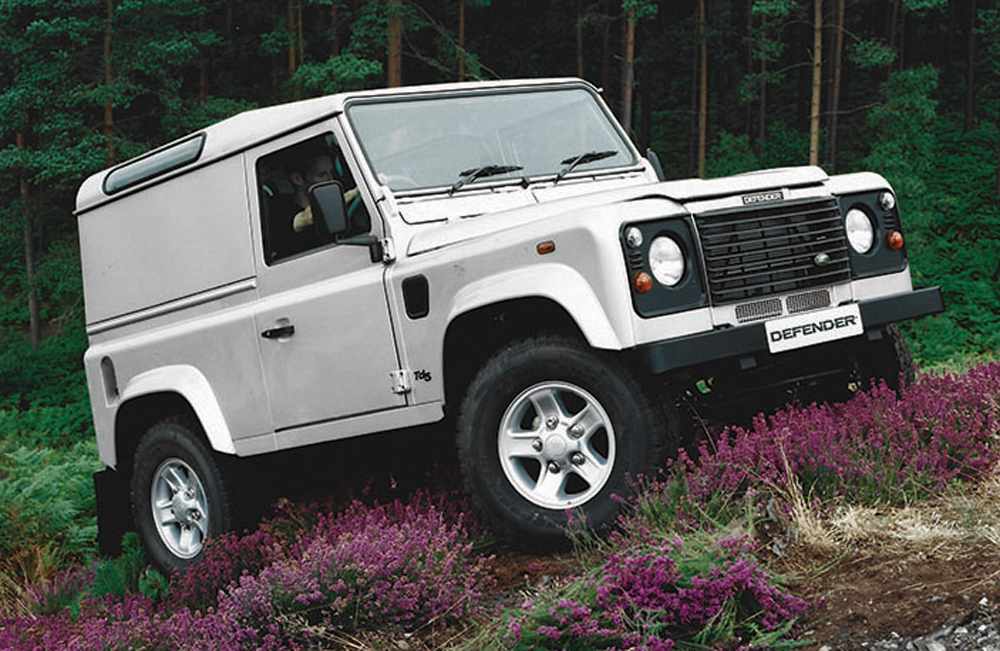
The 2000s were a bit hit-and-miss for special editions – some were less special than others. And 2000’s X-Tech is a case in point. Available in Blenheim Silver with matching roof and wheelarches, the £19,995 ‘no compromise’ Td5 90 hard tops had alloy wheels, alloy gearknob and leather steering wheel. Which is probably why nobody really remembers them. We’ve not seen a standard one for sale for yonks – but don’t expect to pay much of a premium for one.
We’d like to say that the 2003 X-Tech was more memorable, but it wasn’t really, despite the brochure saying it ‘makes a statement’. That was also finished in Silver, but the exotic-sounding Zambezi this time, had black part-leather seats, air con and Brunel Silver grille, headlamp surrounds and centre switch panel. It also had the cold climate pack, leather gearknob and steering wheel. It retailed at £21,895. Again, it’s a curio, but is it much more desirable than a standard Defender in similar condition? Probably not.
Tomb Raider, 2001, Td5

Being featured in a film is always a good way to promote a vehicle and despite being on screen for a matter of seconds, the V8 Defender 110 Hi Cap that starred in Tomb Raider made a sizeable impression. Sadly, the Tomb Raider special editions were neither V8s nor Hi Caps, but the Bonatti Grey 90 station wagons and 110 double cabs certainly looked the part with their external roll cage, roof rack, raised air intake, light guards and extra lights. With colour-coded wheel centres and contrasting chequerplate on the sides as well as the wings, together with Illuminati decals, these vehicles were built for using – and many were. Only 250 were made to be sold around the world and you’re looking at £25-£30k for a good one these days.
Braemar, 2001, Td5

Another Blenheim Silver 90 hard top, the Braemar special edition range ran across the full model range – you could also have a Range Rover P38, Freelander 1 or Discovery 2. As well as the County trim pack, the 25 £19,995 Defenders came with raised air intake, A-bar and driving lamps, chequerplate wingtops and Warn M6000 winch and bumper.
With numbers few, they are rare things, but that doesn’t really translate to being worth more – expect to pay about the same as for a standard model.
Black, 2002, Td5
The success of the Tomb Raider special edition spurred Land Rover into putting out a similar model – the Defender Black – the following year. Also available in 90 station wagon and 110 double cab, both priced at £24,995, they enjoyed Java Black micatallic paint contrasted with silver chequerplate and ‘external screen protection bar’. Wearing Boost alloy wheels, they also had a rear step, leather seat facings, chrome bezel instrument pack, alloy controls and black carpet and trim. Quite rare now, we can’t find a photo in the LRM archive…
G4 Edition, 2003, 2.4 TDCi

Introduced to celebrate the first Land Rover G4 Challenge, these Defenders follow a fairly well-trodden path now, with the windscreen protection bar being the most obvious addition, if you exclude the colour schemes. As well as the relatively dull Java Black and Zambezi Silver models, funkier Borrego Yellow and Tangiers Orange versions were also to be had – but as numbers were limited, there aren’t that many of each kicking around, with yellow being the rarest. Additional kit included a soft A-bar, headlamp guards, black chequerplate, side and rear steps and badges, while the seats had a Black Mogul bobbly fabric. Not as sought-after as genuine event vehicles, they still fetch a premium over standard models.
Silver, 2005, Td5

Like the older X-Tech editions, the Silver is a blink-and-you’ll-miss it model. Available as Td5 90 and 110 station wagons, plus 110 double cab, the models featured soft A-bar, driving lights, hinged light guards, sump guard, contrasting black chequerplate, half-leather seats and CD player. Prices started at £24,595 for the 90, with the 110 double cab just £200 more. The 110 station wagon would have set you back £26,995. Because there’s nothing especially obvious to differentiate the Silver from lightly modified Defenders of the time, you may not notice that it’s something special, and that is reflected in current prices; they’re definitely one of the more affordable limited editions.
SVX, 2008, Td5
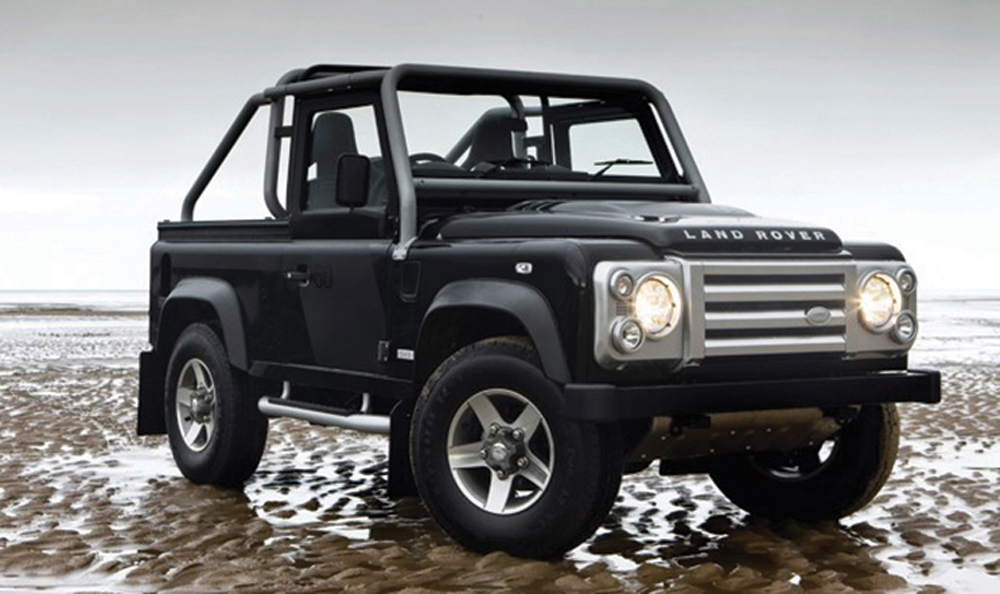
When it was launched, the 60th anniversary Defender stood out from the rest of the range – it had echoes of the SVX concept vehicle shown in 1998. Although the station wagon version (90 worldwide, 110 outside the UK) with its contrasting grille and headlamp surrounds, steps, diamond-turned alloys and satin black decals wasn’t too in-your-face, the soft top versions harked back to the 90SV and NAS 90 models – with the windscreen protection bar and thick hoop at the back, it did look like a bit of a plaything. The Recaro seats keep you in place and at least it has a hood, even if it’s a right faff to fit and still suffers the same water ingress problems that NAS 90s endured more than a decade before. Starting at £30,495 at launch, the 2.4-litre models were a lot of money compared with the rest of the range at the time, and many languished on dealer forecourts for a while. But now they’re looked on affectionately, and the soft top versions, especially, hold their money. £30k will get you into the 60th club these days, or if you want a super-low mileage one, you’ll need almost double that…
X-Tech, 2011, 2.2 TDCi

By the time 2011 arrived, Land Rover knew exactly how to make X-Tech Land Rovers – this was the name’s third outing. And this time it was available in Zermatt Silver and had a Santorini Black roof panel. The stand-out addition was the introduction of the Sawtooth alloys in gloss black and silver chunky grille and light surrounds. The interior also had the black treatment, with Ebony trim and part-leather seats with Land Rover embossed into the headrests. Propelled by the 2.2-litre TDCi engine, the edgy X-Tech would have set you back £24,995 new. These days they do see a bit of a premium over standard, as the colour scheme has been adopted by others.
X-Tech, 2012, 2.2 TDCi
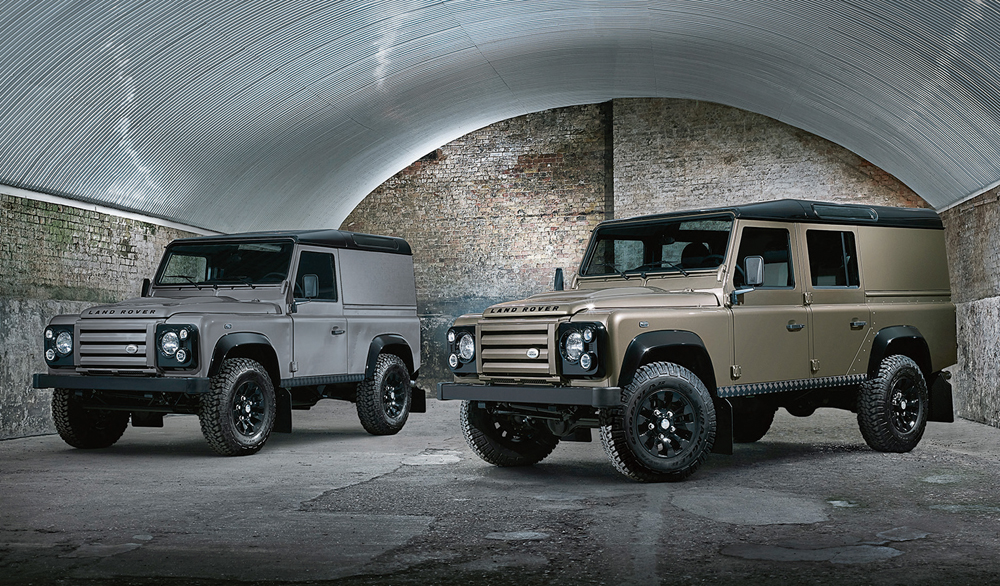
Another year, another X-Tech. This time the special edition was available in Orkney Grey or Nara Bronze, both with a Santorini Black roof. But while the previous incarnations of the X-Tech had all been 90 hard tops, the 2012 was also available in 110 Utility Wagon form. Gloss black Sawtooth alloys were carried over from the 2011 model, as were the grille and headlamp surrounds, while a rear NAS step finished off the rear. Starting price was £27,995, and in original, unmolested condition, they’re worth more than standard, especially the 110 Utility Wagons.
Autobiography, Adventure and Heritage, 2015, 2.2 TDCi

Autobiography
Top of the trio and limited to just 80 versions (according to Land Rover at the time, 100 is now quoted by many), the Autobiography got its name from the bespoke Range Rover builds carried out by the Special Vehicles division. With a starting price of £61,845 it was twice the price of a Heritage, but came with so much more. Duo-tone paintwork was unlike the factory had produced before, while the plush interior included full Windsor leather, including Ebony or Ivory headlining, Semi-aniline premium leather seats with twin-needle contrast stitching and embossed Autobiography logo, aluminium touchpoints, spun metal discs in cup-holder slots, and much more. Outside it got LED headlamps, Sawtooth alloy wheels, side steps and badging. A rapid seller, you’ll be looking at paying £75,000 for a good one these days.
Adventure
Tucked in the middle of the three editions, it nodded to Land Rover’s overlanding heritage, and although all of the Adventures were sold, the 600 weren’t snapped up as quickly as the others. You could have them in Corris Grey, Yulong White or the eye-catching Phoenix Orange contrasted by Santorini Black Adventure grille, wheelarches, bonnet, roof and rear door. The outside also benefited from a raised air intake, expedition roof rack and rear access ladder, together with underside protection in the form of a sump guard and sill protectors. Diamond-turned wheels sported Goodyear MT/R tyres and LED headlamps showed the way ahead. Inside you were treated to Windsor leather upholstery and front passenger fascia, leather-trimmed door panels, Ebony Alston headlining, leather steering wheel and more. Even the 2.2-litre TDCi engine had a mild tune giving it a bit more poke than standard. Once you experienced the Adventure, you could see its appeal, and they are still sought-after now – and you’ll struggle to find one for less than £50,000, with dealers asking £80,000 for the best low-mileage examples.
Heritage
The most authentic of the three special editions to celebrate the end of Defender production, the Heritage followed the same path forged by the original Heritage in 1999, but this time was only available in pastel Grasmere Green, with contrasting Alaska White roof. It was available as a hard top in 90 form and station wagon in both 90 and 110 models. Like the previous Heritage, it had silver hinge detailing and aluminium touchpoints, including the door handles and locks together with aluminium finish clock and vent bezels. Upgraded seats trimmed with Almond Resolve cloth with Ebony vinyl sides were complemented by a leather steering wheel, gearknob and handbrake lever, while outside it received Heritage-style badges and mudflaps and HUE 166 graphics. With prices starting at £27,800, it was the cheapest of the three editions and all 400 UK models sold quickly. They still command a healthy price, but the number of copycat rebuilds has dented the value slightly – expect to pay £35,000-£55,000 for one.
LXV, 2013, 2.2 TDCi

The LXV was Land Rover’s 65th anniversary offering – LXV is 65 in Roman numerals – and there were 65 of the upgraded hard tops available. The Santorini Black 90 featured the standard 2.2-litre TDCi engine and drivetrain and had a contrasting Corris Grey roof, grille, headlight surrounds and fascia. LXV embossed headrests finished off the full leather seats, while orange contrast stitching added a hint of colour. Pricing started at £28,785 and discreet decals told other road users what you were driving, while the now familiar Sawtooths adorned the axles. These days you’ll have to go north of £35,000 to buy one.
Landmark, 2015, 2.2 TDCi
With all of the attention on the three show-stopper special editions, the Landmark failed to register on many radars, but a few were sold. Available in 90 and 110 station wagon forms, it was pitched higher than the top-spec XS station wagons, and prices kicked off at £34,995 for the 90 and £37,995 for the 110. It could be ordered in Montalcino Red, Santorini Black or Yulong White and enjoyed the Black Design pack, which included black roof and wheelarches. Inside, you got premium heated leather seats, leather steering wheel, air con and 150W Bluetooth audio system with subwoofer. As people missed them when they were new, they could be a bit of an end-of-line rarity today.
Classic Works V8, 2018, 5.0-litre V8 petrol
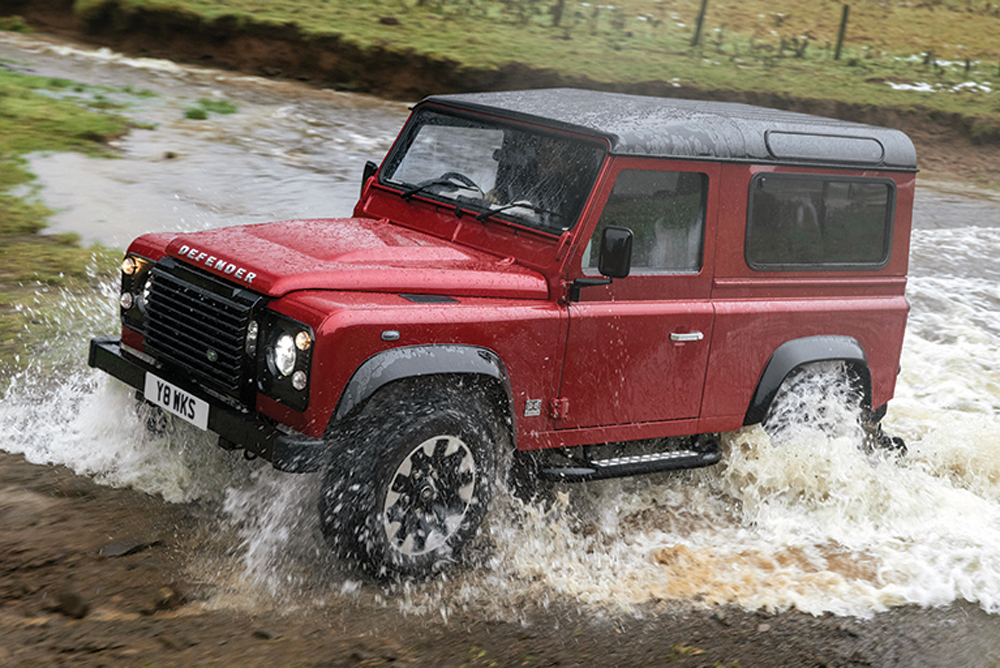
How better to celebrate the 70th anniversary than to put out a special edition of the vehicle the company no longer made. The Works V8s weren’t a production-line build, but were created by the company’s Classic Works. Starting at £150k, the company definitely had a prospective buyer in mind, but they did get a fully reworked Defender in white, grey, black or Roma Red, 5.0-litre V8 engine coupled to an eight-speed automatic gearbox, uprated suspension and brakes and leather interior. Examples that have changed hands since 2018 have sold for more than the original purchase price – a sound investment.
Works V8 Trophy, 2021, 5.0-litre V8 petrol

With echoes of the Camel Trophy Land Rovers, the Land Rover Trophy Defenders were available in 90 and 110 form, and painted in a sandy Eastnor Yellow with black highlights. Prices for the limited run of 25 vehicles started at just under £200,000, but that did involve a few days of almost money-can’t-buy competition at Land Rover’s Eastnor Castle proving ground – and for many of the owners it was their first chance to see their vehicles. Featuring the same 5.0-litre V8 and eight-speed automatic transmission as the Works V8, the Trophy vehicles also had Windsor leather-trimmed Recaro seats, Elliot Brown centrepiece clock, a winch, roof rack and driving lamps.
Works V8 Trophy II, 2022, 5.0-litre V8 petrol

Announced at the inaugural Land Rover Trophy event, several of the 25 models, including all of the 110 double cabs, were snapped up instantly by owners of Trophy I vehicles. This time the paint scheme was more Arctic, with an adventure-inspired black camouflage featuring 23 locations from Land Rover’s history overlaying the Fuji White paint. The engine, transmission and interior followed the familiar Works V8 theme, and again included an Elliot Brown clock, together with an exclusive Competitor’s Edition watch. Winch, expedition exterior roll cage, roof rack and light bar finish the exterior, and the starting price was £225,000.
The Trophy Land Rovers are proper collector’s vehicles and, as such, if and when they do appear on the market, they will be selling for more than they
originally cost.
Works V8 Islay, 2023, 5.0-litre V8 petrol
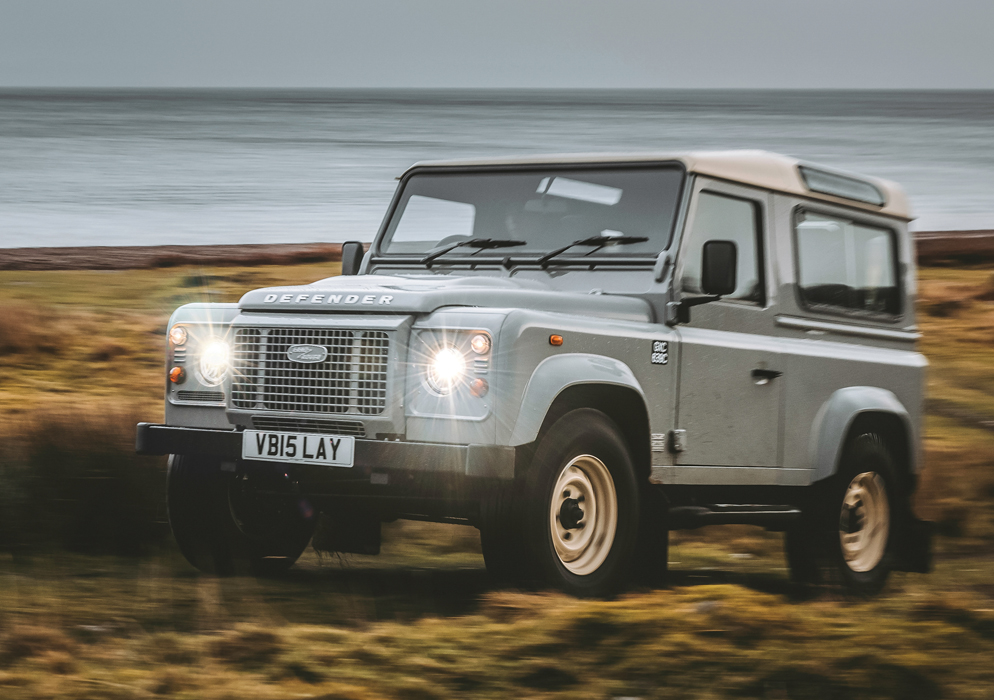
Again using Land Rover’s heritage as its basis, the £230,000 Islay edition went back to the origins of the Land Rover name, where the original 4x4 was once tested. “If the car’s a Rover, then this must be a ‘Land Rover”’, the conversation went, and the name stuck. Finished in Mid Grey, a nod to Spencer Wilks’ 1965 Series IIA, the Defenders also carry that vehicle’s registration number (GXC 639C) on the wings. The door cards, central armrest, sun visors and Recaro seats all feature tweed crafted by the Islay Woollen Mill, and wood veneer detailing extends into the rear and centre console. Another collector vehicle, these are unlikely to lose their value.
Overseas models
As well as the special edition Defenders available in the UK and worldwide, numerous editions have been sold in specific overseas markets. Here are just a handful of those available and they’re worth looking out for if you’re really after something different.
NAS Defender 110, 1992, 3.9-litre V8 petrol
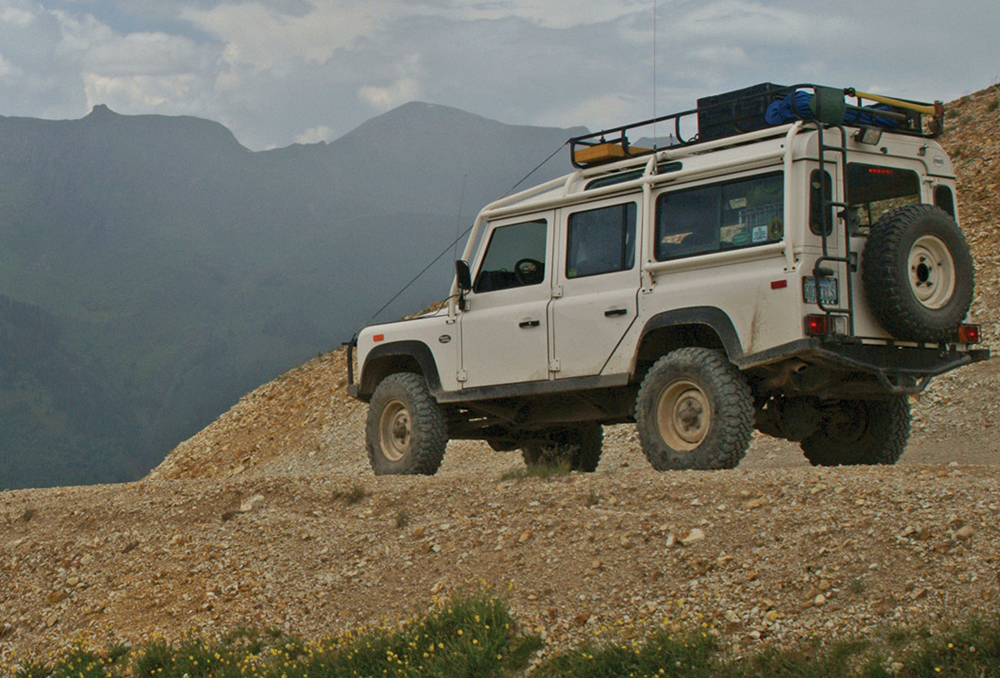
Is the NAS (North American Specification)Defender 110, instantly recognisable with its white paint finish and exoskeleton roll cage, a limited edition? Some say no, as it was the only way you could buy a new Defender from a dealer in North America – therefore it’s a standard model. But as each was individually numbered and there were only 500 of them, others say ‘yes’. Fitted with a 3.9-litre V8 engine, five-speed manual gearbox, wide steel wheels, bull bar and roof rack, the NAS Defender 110s exuded a true sense of adventure. They epitomised what the Defender stood for with the US buyers – rugged, capable and distinctly British. They may have sold for $34,000 (£22k) when new, but by the mid-2000s their value had rocketed to $100,000 plus and they haven’t really dropped since. Bonhams had one in its auction in Arizona at the end of January (after this issue went to print). In good condition and with 142,000 miles, the estimate was $110k-$130k (£87k-£102k at time of writing). Compare that with later imports selling for around $25k-$30k and demand is still there.
NAS 90, 1994-1997, 3.9 and 4.0-litre V8

Some may, with good reason, say the NAS 90 is the ultimate Defender. With its V8 engine, five-speed gearbox and primary colour paintwork, it was designed to be seen and had California cool. It was British, but shod with BFGoodrich tyres and a substantial bull bar, it was as US as it came. One even made a cameo appearance in the video for Britney Spears’ debut hit Baby One More Time. Yellow was the colour to have if you wanted to be seen, but it was also available in red, green blue and white (and later, black). Although most people know about the soft top version with its optional rear bench seat, you could also have a station wagon – and early buyers of the soft top probably wished they’d gone for the latter as the weather sealing wasn’t great on the soft tops. A replaceable fibreglass top option was also available. Early models had square rear lights, but they were replaced by the more common 95mm round NAS lights for 1995, and the original 3.9-litre engine was also superseded by a 4.0-litre unit, and a four-speed automatic gearbox was the only transmission option for the final year.
When new, the first NAS 90s would have set you back a mere $27,900 (£17,800), but you’ll struggle to find one for less than $100,000 (£79,000) now – and if you fancy a time-warp 1997 model with just over 4000 miles on the clock, there’s one currently up for sale for $170k (£134k).
Eastnor and X-Trem, 1996, 300Tdi

Made for the French market, with the Eastnor painted yellow and the X-Trem finished in red and blue, these special editions tried to capture the appeal of the NAS Defenders. The X-Trem had a folding soft top, or fastback-style hard top while the Eastnor had a more traditionally shaped removable fibreglass glazed hard top with lifting top tailgate. Both had a roll hoop behind the front seats, A-bar and driving lamps, side and rear steps, side-hinged tailgate and spare wheel carrier. A Td5-engined X-Trem 2 followed in 2000.
Fire and Ice, 2009, 2.4-litre TDCi

The Fire and Ice editions – finished in Vesuvius Orange and Alaska White respectively – brought us the Santorini Black roof that has featured on special editions since. Available in 16 countries, but not the UK, these were actually special and not just accessory-box upgrades. With a starting price of €68,400 (£57,500), they weren’t cheap, but you did get leather Recaro seats, Alcantara trim, colour-coded headlight surrounds and diamond-turned wheels – in many ways they weren’t dissimilar to 2008’s SVX station wagons. 850 were due to be made, but we don’t think that many were actually sold – the price may have been a bit excessive, but it did give us a taste of what to expect on 2015’s Autobiography models. Worth looking for if you want something different.
Defender Special Edition/Rough II, 2012, 2.2 TDCi

Visually similar to 2012’s X-Tech offerings in the UK, the Defender Special Editions were destined for the rest of the world and were available in 90 and 110 station wagon format, rather than the UK commercials. Sold as Rough II editions in Germany with a starting price of €39,600 (£31,240), they were also available in Nara Bronze (120 units) and Orkney Grey (30 units), both with Santorini Black roofs. They featured part-leather seats, body-colour SVX grille, SVX headlight set, LED rear lights, Sawtooth alloys,rear mudflaps and chequerplate protection.
New Defender
Despite having a bewildering number of possible options for standard vehicles, buyers of the latest Defender have already been offered special editions in the UK and overseas.
V8 Bond Edition, 2021, 5.0-litre V8 petrol

The 25th James Bond film, No Time To Die, featured the new Defender and it was due to be released in cinemas not long after the new Defender had been launched – then Covid kicked that into touch. It did mean, however, that Land Rover was able to have time to craft a limited edition for the film, and use the supercharged V8 engine. Three hundred of the 90 and 110 versions were available and they included such details as 007 puddle lamps and tread plates. Starting price was £105,395 but you’ll struggle to find one for that now – the Bond link is incredibly powerful.
Land Rover Trophy, 2021 and 2022, P400

With limited runs of 220 models in 2021 and 250 in 2022 (30 sold at dealers in Canada), the Defender Trophy Edition features a wrap inspired by the Works V8 Trophy produced by Land Rover Classic Works. The base models are X-Dynamic SE models and enhanced with an expedition roof rack, front undershield, side ladder, winch installation kit and air compressor. Buyers also got the chance to participate in the Trophy Competition, with the winners being flown to the UK to take part in the Works V8 Trophy events. The 2021 model was priced at $90,000 (£66,700), while 2022 models were $95,000 (£80,500).
75th Anniversary, 2023, P400e and D300
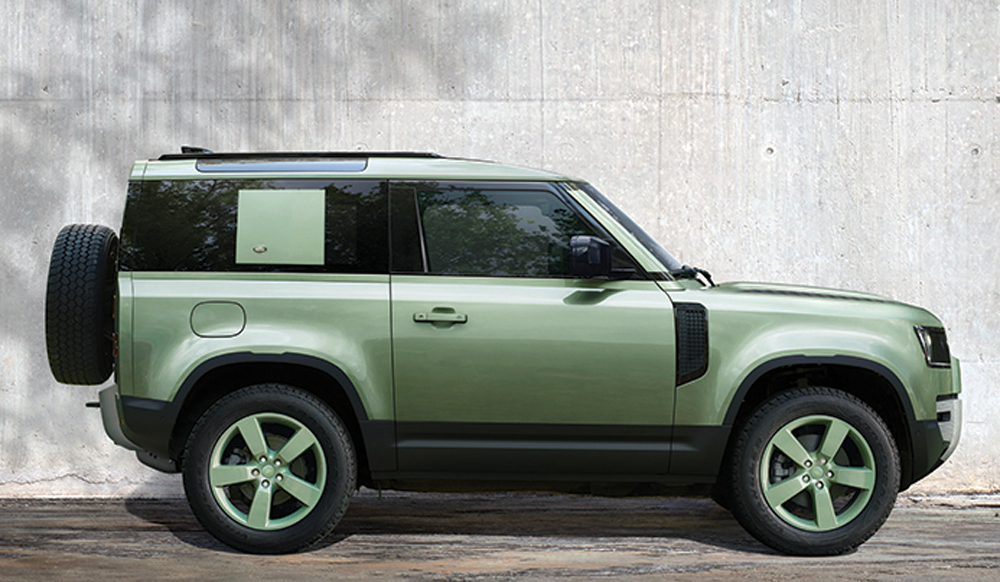
Carrying on Land Rover’s Heritage theme, the 75th Anniversary models were painted the same Grasmere Green that adorned the classic Defender models, but while the seats on the older limited editions were lighter, Resist Ebony ones are fitted to this and the centre console feature the durable Robustec material. Outside, the 20-inch alloys were colour-coded to the bodywork, while silver bumpers added contrast to the paintwork. Privacy glass was standard, and you got a folding fabric roof or the option of a sliding panoramic roof with roof rails. Prices started at £85,995 for the 90 and you can pick them up secondhand with a few thousand miles on the clock for £70k.
Marine Blue Edition, 2023, D250
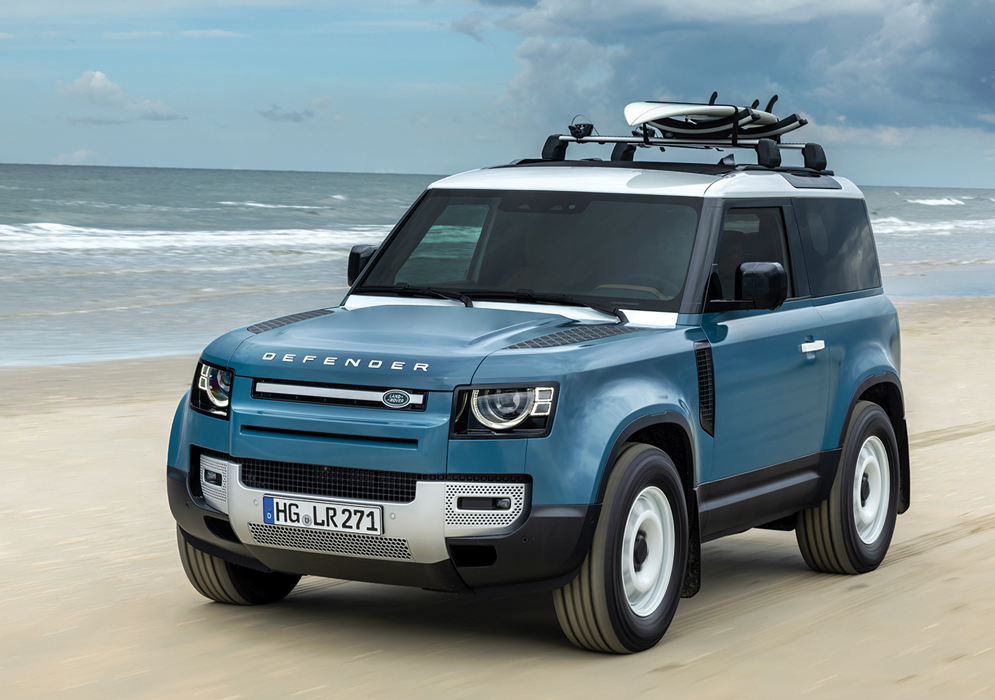
Built for the German market, the Marine Blue Edition was limited to just 25 units and the launch coincided with the Defender GKA Kitesurf World Cup. Priced at €99,800 (£86,770), they have a distinct retro look thanks to the blue wrap paired with 18-inch white steel wheels. Accessories included a side carrier and special Aquasport roof rack to carry a special Defender surfboard.
Like to have your own Land Rover library?
Try our All-Access Digital Subscription. You'll get access to over 7 years of Land Rover Monthly – that’s more than 100 issues plus the latest digital issue. All issues are fully searchable so you can easily find what you are looking for and what’s more it’s less than 10p a day to subscribe. Click the link above to find out more details and start enjoying all the benefits now.






